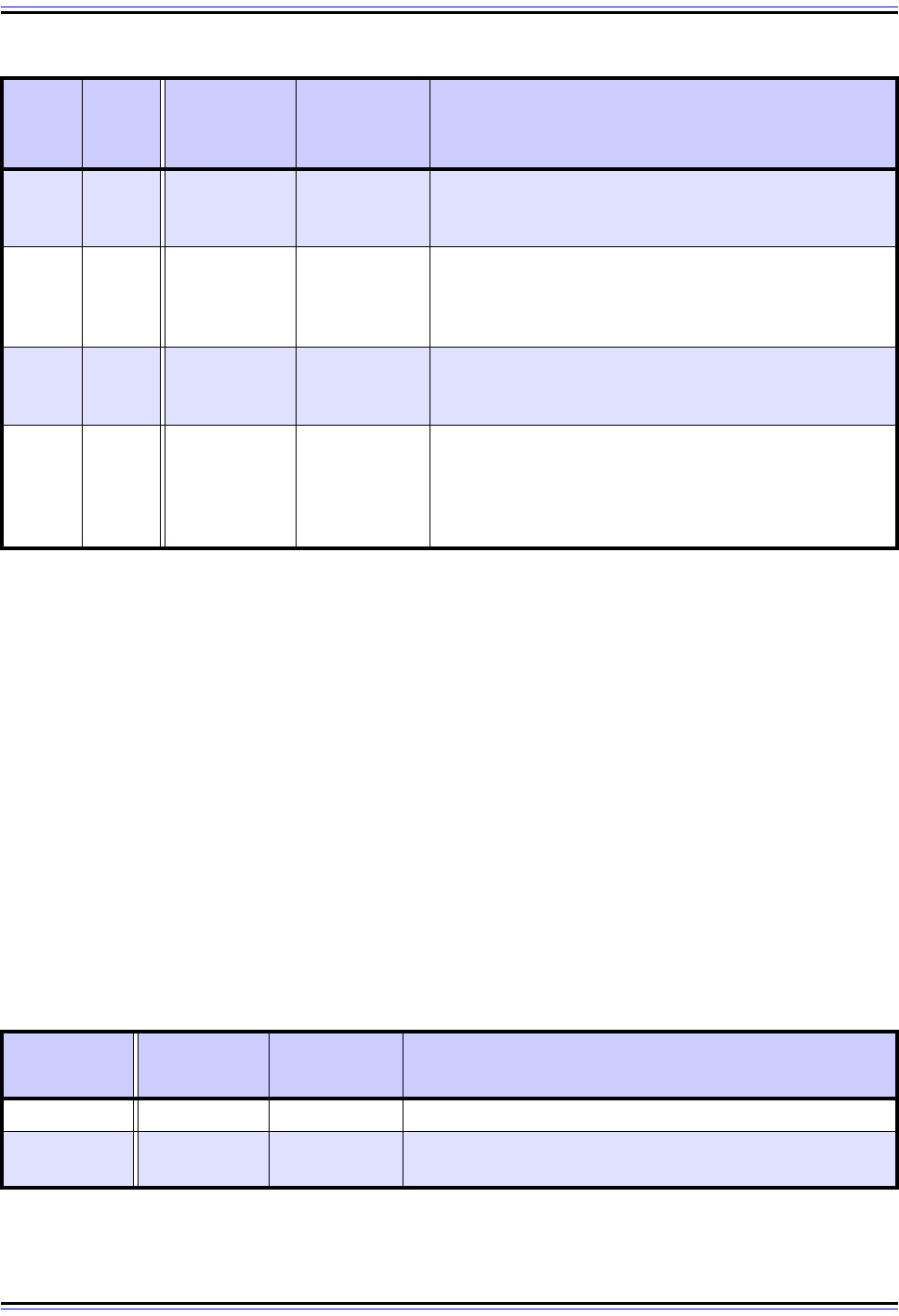Charles M. Kozierok The TCP-IP Guide
Подождите немного. Документ загружается.


The TCP/IP Guide - Version 3.0 (Contents) ` 1091 _ © 2001-2005 Charles M. Kozierok. All Rights Reserved.
As you can see, XDR provides considerable data description capability. If you know the “C”
language, much of what is in that table is probably familiar to you. Unfortunately, I can't
really describe many of the more complex data types in the table above in detail without
turning this into a guide to C programming.
In addition to the above, XDR also provides a means of defining new data types, and a
method for specifying optional data. This provides even more flexibility beyond the large
number of specific types already specifically described. Each version of NFS has a slightly
different list of data types it supports.
NFS Client/Server Operation Using Remote Procedure Calls (RPCs)
Almost all applications deal with files and other resources. When a software program on a
particular computer wants to read a file, write a file or perform related tasks, it needs to use
the correct software instructions for this purpose. It would be inefficient to require each
software program to contain a copy of these instructions, so instead, they are encoded as
float 4
Floating-Point Number: A 32-bit signed floating-point number. 1 bit holds
the sign (positive or negative), 8 bits hold the exponent (power), in base 2,
and 23 bits hold the mantissa (fractional part of the number).
double 8
Double-Precision Floating-Point Number: The same as float but with
more bits to allow greater precision. 1 bit is for the sign, 11 bits for the
exponent and 52 bits for the mantissa.
quadruple 16
Quadruple-Precision Floating-Point Number: The same as float and
double but with still more bits to allow greater precision. 1 bit is for the sign,
15 bits for the exponent and 112 bits for the mantissa.
opaque Variable
Opaque Data: Data that is to be passed between devices without being
given a specific representation using XDR. The term opaque means that
the data is treated like a “black box” whose insides cannot be seen.
Obviously, any machines using this data type must themselves know how
to deal with it, since NFS does not.
string Variable String: A variable-length string of ASCII characters.
(array) Variable
Arrays: A group of any single type of the elements above, such as
integers, floating point numbers and so on, may be specified in an array to
allow many to be referenced as a single unit. They are not indicated using
a separate data type code.
struct Variable
Structure: An arbitrary structure containing other data elements from this
table. This allows the definition of complex data types.
union Variable
Discriminated Union: A complex form of structure that I cannot do justice
to with a short description here. ☺
void 0 Void: A “null” data type that contains nothing.
const 0
Constant: Doesn't declare data, just defines a constant value used in other
representations.
Table 182: NFS External Data Representation (XDR) Data Types (Page 2 of 2)
Data Type Code
Size
(bytes)
Description

The TCP/IP Guide - Version 3.0 (Contents) ` 1092 _ © 2001-2005 Charles M. Kozierok. All Rights Reserved.
standardized software modules, sometimes called procedures. To perform an action, a
piece of software calls the procedure; the procedure temporarily takes over for the main
program and performs a task such as reading or writing data. The procedure then returns
control of the program back to the software that called it, and optionally, returns data as
well.
Since the key concept of NFS was to make remote file access look like local file access, it
was designed around the use of a network-based version of the procedure calling method
just described. A software application that wants to do something with a file still makes a
procedure call, but it makes the call to a procedure on a different computer instead of the
local one. A special set of routines is used to handle the transmission of the call across the
network, in a way largely invisible to software performing the call.
This functionality could have been implemented directly in NFS, but instead Sun created a
separate session-layer protocol component called the Remote Procedure Call (RPC) speci-
fication, which defines how this works. RPC was originally created as a subcomponent of
NFS, but is generic enough and useful enough that it has been used for other client/server
applications in TCP/IP. For this reason, it is really considered in many respects a distinct
protocol.
Because RPC is the actual process of communicating in NFS, NFS itself is different from
many other TCP/IP protocols. Its operation can't be described in terms of specific message
exchanges and state diagrams the way a protocol like HTTP or DHCP or even TCP can,
because RPC does all of that. NFS is in fact defined in terms of a set of RPC server proce-
dures and operations that an NFS server makes available to NFS clients. These
procedures and operations each allow a particular type of action to be taken on a file, such
as reading from it, writing to it or deleting it.
RPC Operation and Transport Protocol Usage
When a client wants to perform some type of action on a file on a particular machine, it uses
RPC to make a call to the NFS server on that machine. The server accepts the request and
performs the action required, then returns a result code and possibly data back to the client,
depending on the request. The result code indicates if the action was successful. If it was,
the client can assume that whatever it asked to be done was completed. For example, in
the case of writing data, the client can assume the data has been successfully written to
long-term storage.
NFS can operate over any transport mechanism that has a valid RPC implementation at the
session layer. Of course in TCP/IP we have two transport protocols, UDP and TCP
. It's
interesting to see that NFS has seen an evolution of sorts in its use of transport protocol.
The NFSv2 standard says that it operates “normally” using UDP, and this is still a common
way that NFS information is carried. NFSv3 says that either UDP or TCP may be used, but
NFSv4 specifies TCP to carry data. The nominal registered port number for use by NFS is
2049, but in fact other port numbers are sometimes used for NFS, through the use of RPC's
“port mapper” capability.

The TCP/IP Guide - Version 3.0 (Contents) ` 1093 _ © 2001-2005 Charles M. Kozierok. All Rights Reserved.
Key Concept: NFS does not use a dedicated message format, like most other
protocols do. Instead, clients and servers use the Remote Procedure Call (RPC)
protocol to exchange file operation requests and data.
Client and Server Responsibilities in NFS
Since UDP is unreliable, the use of that protocol to transport important information may
seem strange. For example, we obviously don't want data that we are trying to write to a file
to be lost in transit. Remember, however, that UDP doesn't preclude the use of measures to
ensure reliable communications, it simply doesn't provide those capabilities itself. UDP can
be used by NFS because the protocol itself is designed to tolerate loss of transmitted data
and to recover from it.
Consistent with this concept, the general design of NFS puts most of the responsibility for
implementing the protocol on the client, not the server. As the NFSv3 standard says, “NFS
servers are dumb and NFS clients are smart.” What this means is that the servers focus
only on responding to requests, while clients must take care of most of the “nitty-gritty”
details of the protocol, including recovery from failed communications. This is in fact a
common requirement when UDP is used, because if a client request is lost in transit, the
server has no way of knowing that it was ever sent.
As mentioned in the NFS overview, NFS servers are designed to be “stateless”. In
simplified terms, this means that the NFS server does not keep track of the state of the
clients using it from one request to another. Each request is independent of the previous
one, and the server in essence has “no memory” of what it did before when it gets a new
command from a client. This again requires more “smarts” to be put into the clients, but has
the important advantage of simplifying recovery in the case that the server crashes. Since
there is nothing that the server was keeping track of for the client, there's nothing that can
be lost. This is an important part of ensuring that files are not damaged as a result of
network problems or congestion.
Client and Server Caching
Both NFS clients and servers can make use of caching to improve performance. Servers
may use caching to store recently-requested information in case it is needed again. They
may also use predictive caching, sometimes called prefetching. In this technique, a server
that receives a request to read a block of data from a file may load into memory the next
block after it, on the theory that it will likely be requested next. Client-side caching is used to
satisfy repeat NFS requests from applications while avoiding additional RPC calls. Like
almost everything else about NFS, caching is implemented much more thoroughly in NFS
version 4 than in the previous versions.

The TCP/IP Guide - Version 3.0 (Contents) ` 1094 _ © 2001-2005 Charles M. Kozierok. All Rights Reserved.
Key Concept: NFS is designed to be a stateless protocol, with intelligent clients and
relatively “dumb” servers that respond to requests and do not maintain status infor-
mation about what files are in use. NFS was originally designed to use UDP for
transport, for efficiency purposes. This requires that NFS clients take care of detecting lost
requests and retransmitting them. NFS version 4 uses TCP to take advantage of TCP’s
reliability and other features.
NFS Server Procedures and Operations
The actual exchange of information between an NFS client and server is performed by the
underlying Remote Procedure Call (RPC) protocol. NFS functionality is therefore described
not in terms of specific protocol operations, but by delineating the different actions that a
client may take on files residing on a server. In the original version of NFS, NFSv2, these
are called NFS server procedures.
Each procedure represents a particular action that a client may perform, such as reading
from a file, writing to a file, or creating or removing a directory. The operations performed on
the file require that the file be referenced using a data structure called a file handle. As the
name suggests, the file handle, like the handle of a real object, lets the client and server
“grasp” onto the file. The Mount protocol is used to mount a file system, to enable a file
handle to be accessed for use by NFS procedures.
NFS version 3 uses the same basic model for server procedures, but makes certain
changes. Two of the NFSv2 procedures were removed, and several new ones added to
support new functionality. The numbers assigned to identify each procedure were also
changed.
NFS Version 2 and Version 3 Server Procedures
Table 183 shows the server procedures defined in versions 2 and 3 of NFS. The table
shows the procedure numbers for both NFSv2 and NFSv3, as well as the name of each
procedure and a description of what it does. I have kept the descriptions short so the table
can serve as a useful summary of what NFS can do. They are listed in order of the
procedure number used in NFSv2.
Table 183: NFS Version 2 and Version 3Server Procedures (Page 1 of 3)
Proce-
dure #
(v2)
Proce-
dure #
(v3)
Procedure
Name
Procedure
Summary
Description
00 null Do Nothing Dummy procedure provided for testing purposes.
1 1 getattr
Get File
Attributes
Retrieves the attributes of a file on a remote server.
22 setattr
Set File
Attributes
Sets (changes) the attributes of a file on a remote
server.

The TCP/IP Guide - Version 3.0 (Contents) ` 1095 _ © 2001-2005 Charles M. Kozierok. All Rights Reserved.
3 — root
Get
Filesystem
Root
(obsolete)
This procedure was originally defined to allow a client
to find the root of a remote file system, but is now
obsolete. This function is instead now implemented as
part of the Mount protocol. It was removed in NFSv3.
43 lookup
Look Up File
Name
Returns the file handle of a file for the client to use.
5 5 readlink
Read From
Symbolic Link
Reads the name of a file specified using a symbolic
link.
66 read
Read From
File
Reads data from a file.
7 — writecache
Write To
Cache
Proposed for future use in version 2 but abandoned
and removed from version 3.
87 write Write To File Writes data to a file.
9 8 create Create File Creates a file on the server.
10 12 remove Remove File Deletes a file from the server.
11 14 rename Rename File Changes the name of a file.
12 15 link
Create Link To
File
Creates a “hard' (non-symbolic) link to a file.
13 10 symlink
Create
Symbolic Link
Creates a symbolic link to a file.
14 9 mkdir
Create
Directory
Creates a directory on the server.
15 13 rmdir
Remove
Directory
Deletes a directory.
16 16 readdir
Read From
Directory
Reads the contents of a directory.
17 — statfs
Get File
System
Attributes
Provides to the client general information about the
remote file system, including the size of the file system
and the amount of free space remaining.
In NFSv3 this was replaced by fsstat and fsinfo.
—4 access
Check Access
Permission
(New in NFSv3.) Determines the access rights that a
user has for a particular file system object.
— 11 mknod
Create A
Special
Device
(New in NFSv3.) Creates a special file such as a
named pipe or device file.
—17readdirplus
Extended
Read From
Directory
(New in NFSv3.) Retrieves additional information from
a directory.
Table 183: NFS Version 2 and Version 3Server Procedures (Page 2 of 3)
Proce-
dure #
(v2)
Proce-
dure #
(v3)
Procedure
Name
Procedure
Summary
Description

The TCP/IP Guide - Version 3.0 (Contents) ` 1096 _ © 2001-2005 Charles M. Kozierok. All Rights Reserved.
NFS Version 4 Server Procedures and Operations
It is common that a client may want to perform multiple actions on a file: several consec-
utive reads, for example. One of the problems with the server procedure system in NFSv2
and NFSv3 is that each client action required a separate procedure call. This was
somewhat inefficient, especially when NFS was used over a high-latency link.
To improve the efficiency of server procedures, NFS version 4 makes a significant change
to the way that server procedures are implemented. Instead of each client action being a
separate procedure, a single procedure called compound is defined. Within this
“compound” procedure, a large number of server operations are encapsulated. These are
all sent as a single unit and the server interprets and follows the instructions in each
operation in sequence.
This change means there are actually only two RPC procedures in NFSv4, as shown in
Table 184.
— 18 fsstat
Get Dynamic
File System
Information
(New in NFSv3.) Returns volatile (dynamic) file system
status information such as the current amount of file
system free space and the number of free file slots.
—19 fsinfo
Get Static File
System
Information
(New in NFSv3.) Returns static information about the
file system, such as general data about how the file
system is used, and parameters for how requests to
the server should be structured.
— 20 pathconf
Retrieve
POSIX
Information
(New in NFSv3.) Retrieves additional information for a
file or directory.
—21 commit
Commit
Cached Data
On A Server
To Stab le
Storage
(New in NFSv3.) Flushes any data that the server is
holding in a write cache to storage. This is used to
ensure that any data that the client has sent to the
server but that the server has held pending write to
storage is in fact written out.
Table 184: NFS Version 4 Server Procedures
Procedure #
Procedure
Name
Procedure
Summary
Description
0 null Do Nothing Dummy procedure provided for testing purposes.
1 compound
Compound
Operations
Combines a number of NFS operations into a single
request, as described above.
Table 183: NFS Version 2 and Version 3Server Procedures (Page 3 of 3)
Proce-
dure #
(v2)
Proce-
dure #
(v3)
Procedure
Name
Procedure
Summary
Description

The TCP/IP Guide - Version 3.0 (Contents) ` 1097 _ © 2001-2005 Charles M. Kozierok. All Rights Reserved.
All the real client actions are defined as operations within the compound procedure, as
shown in Table 185. You'll notice that the number of NFSv4 operations is much larger than
the number of procedures in NFSv2 and NFSv3. This is due both to the added features in
version 4 and the fact that NFSv4 incorporates functions formerly performed by the
separate Mount protocol into NFS itself.
Table 185: NFS Version 4 Server Operations (Page 1 of 2)
Operation #
Operation
Name
Operation
Summary
Description
3 access
Check Access
Rights
Determines the access rights a user has for an object.
4 close Close File Closes a file.
5 commit
Commit Cached
Data
Flushes any data that the server is holding in a write
cache to storage, to ensure that any pending data is
permanently recorded.
6 create
Create A Non-
Regular File
Object
This is similar to the mknod procedure in NFSv3; it
creates a “non-regular” (special) object file. (Regular
files are created using the open operation.)
7 delepurge
Purge Delegations
Awaiting
Recovery
NFSv4 has a feature where a server may delegate to
a client responsibility for certain files. This operation
removes delegations awaiting recovery from a client.
8 delegreturn Return Delegation
Returns a delegation from a client to the server that
granted it.
9 getattr Get Attributes Obtains the attributes for a file.
10 getfh
Get Current
Filehandle
Returns a file handle, which is a logical object used to
allow access to a file.
11 link
Create Link To A
File
Creates a “hard' (non-symbolic) link to a file.
12 lock Create Lock
Creates a lock on a file. Locks are used to manage
access to a file, for example, to prevent two clients
from trying to write to a file simultaneously and thus
corrupting it.
13 lockt Te s t Fo r Loc k
Tests for the existence of a lock on an object and
returns information about it.
14 locku Unlock File Removes a lock previously created on a file.
15 lookup Lookup Filename Looks up or finds a file.
16 lookupp
Lookup Parent
Directory
Returns the filehandle of an object's parent directory.
17 nverify
Verify Difference
In Attributes
Checks to see if attributes have changed on a file.
18 open
Open A Regular
File
Opens a file.
19 openattr
Open Named
Attribute Directory
Opens an attribute directory associated with a file.

The TCP/IP Guide - Version 3.0 (Contents) ` 1098 _ © 2001-2005 Charles M. Kozierok. All Rights Reserved.
20 open_confirm Confirm Open Confirms information related to an opened file.
21
open_
downgrade
Reduce Open File
Access
Adjusts the access rights for a file that is already open.
22 putfh
Set Current
Filehandle
Replaces one filehandle with another.
23 putpubfh
Set Public
Filehandle
Sets the current filehandle to be the “public” filehandle
of the server. This may or may not be the same as the
root filehandle (see below).
24 putrootfh
Set Root
Filehandle
Sets the current filehandle to be the root of the
server's file system.
25 read Read From File Reads data from a file.
26 readdir Read Directory Reads the contents of a directory.
27 readlink
Read Symbolic
Link
Reads the name of a file specified using a symbolic
link.
28 remove
Remove
Filesystem Object
Removes (deletes) an object.
29 rename
Rename Directory
Entry
Changes the name of an object.
30 renew Renew A Lease
Renews an NFS delegation made by a server. (Note
that these leases have nothing to do with DHCP
leases!)
31 restorefh
Restore Saved
Filehandle
Allows a filehandle previously saved to be made the
current filehandle.
32 savefh
Save Current
Filehandle
Allows a filehandle to be saved so it can later be
restored when needed.
33 secinfo
Obtain Available
Security
Retrieves NFS security information.
34 setattr Set Attributes Changes one or more attributes of a file.
35 setclientid Negotiate Clientid
Allows a client to communicate information to the
server regarding how the client wants to use NFS.
36
setclientid_
confirm
Confirm Clientid
Used to confirm the results of a previous negotiation
using setclientid.
37 verify
Verify Same
Attributes
Allows a client to verify certain attributes before
proceeding with a particular action.
38 write Write To File Writes data to a file.
39
release_
lockowner
Release
Lockowner State
Used by a client to tell a server to release certain infor-
mation related to file locks.
10044 illegal Illegal Operation
A “placeholder” (dummy) operation used to support
error reporting when an invalid operation is used in a
request from a client.
Table 185: NFS Version 4 Server Operations (Page 2 of 2)
Operation #
Operation
Name
Operation
Summary
Description

The TCP/IP Guide - Version 3.0 (Contents) ` 1099 _ © 2001-2005 Charles M. Kozierok. All Rights Reserved.
Key Concept: File operations in NFS are carried out using NFS server procedures.
In versions 2 and 3 of NFS, each procedure performs one action, such as reading
data from a file. In version 4, a special compound action is defined that allows many
individual operations to be sent in a single request to a server.
NFS File System Model and the Mount Protocol
Since NFS is used by a client to simulate access to remote directories of files as if they
were local, the protocol must “present” the files from the remote system to the local user.
Just as files on a local storage device are arranged using a particular file system, NFS too
uses a file system model to represent how files are shown to a user.
The NFS File System Model
The file system model used by NFS is the same one that most of us are familiar with: a
hierarchical arrangement of directories that contain files and subdirectories. The top of the
hierarchy is the root, which contains any number of files and first level directories. Each
directory may contain more files or other directories, allowing an arbitrary tree structure to
be created.
A file can be uniquely specified by using its file name and a path name that shows the
sequence of directories one must traverse from the root to find the file. Since NFS is
associated with UNIX, files in NFS discussions are usually shown in UNIX notation; for
example, “/etc/hosts”. The same basic tree idea can also be expressed using the method
followed by Microsoft operating systems: “C:\WINDOWS\HOSTS”.
The Mount Protocol
Before NFS can be used to allow a client to access a file on a remote server, the client must
be given a way of accessing the file. This means that a portion of the remote file system
must be made available to the client, and the file opened for access. A specific decision
was made when NFS was created to not put file access, opening and closing functions into
NFS proper. Instead, a separate protocol was created to work with NFS, so that if in the
future the method of providing file access needed to be changed, it wouldn't require
changes to NFS itself. This separate mechanism is called the Mount Protocol, and is
described in Appendix A of RFC 1094 (NFSv2). Note that while functionally distinct, Mount
is considered part of the overall NFS package.
When NFS was revised to version 3, the Mount Protocol was similarly modified. The NFSv3
version of the Mount Protocol is defined in Appendix I of RFC 1813 (NFSv3). It contains
some changes to how the protocol works, but the overall operation of the two versions of
Mount is pretty much the same.

The TCP/IP Guide - Version 3.0 (Contents) ` 1100 _ © 2001-2005 Charles M. Kozierok. All Rights Reserved.
The term “mount” is actually an analog to a hardware term that refers to making a physical
storage volume available. In the “olden dayse” storage devices were usually removable
disk packs, and to use one you mounted it onto a drive unit. In a similar manner, NFS
resources are logically mounted using the Mount protocol, which makes the shared file
system available to the client. A file can then be opened and a file handle returned to the
NFS client so it can reference the file for operations such as reading and writing.
Key Concept: Versions 2 and 3 of NFS do not include procedures for opening or
closing resources on a remote server. Before NFS tasks can be accomplished on
these versions, the special Mount protocol must be employed to mount a filesystem
and create a file handle to access a file on it; the protocol is also used to unmount the file
system when no longer required. The Mount protocol is implemented in a manner very
similar to NFS itself, defining procedures that use RPC and XDR. In version 4 of NFS,
Mount is no longer needed; the tasks it performs are implemented as NFSv4 operations.
Mount Protocol Server Procedures
The actual implementation of the Mount protocol is very similar to that of NFS itself. Like
NFS, the Mount protocol uses XDR to define data types to be exchanged between client
and server, and RPC to define a set of server procedures that clients may use to perform
different operations. The main difference between Mount and NFS is simply that Mount
defines procedures related to opening and closing filesystems rather than file access
operations. Table 186 shows the server procedures used in the Mount protocol.
As mentioned in other topics in this section, NFS version 4 does away with the notion of a
separate Mount protocol, incorporating file mounting operations into NFS directly.
Table 186: NFS Mount Protocol Server Procedures
Procedure #
Procedure
Name
Procedure
Summary
Description
0 null Do Nothing Dummy procedure provided for testing purposes.
1 mnt
Add Mount
Entry
Performs a mount operation by mapping a path on a
server to a file handle for the client to use.
2 dump
Return Mount
Entries
Returns a list of remotely mounted file systems.
3 umnt
Remove
Mount Entry
Performs an “unmount” by removing a mount entry. (It
should be “dismount”. Techies are rarely into grammar. ☺)
4 umntall
Remove All
Mount Entries
Removes all mount entries, thus eliminating all mounted
file systems between server and client.
5 export
Return Export
List
Returns a list of exported file systems and indicates which
clients are allowed to mount them. This is used to let the
client see what served file systems are available for use.
